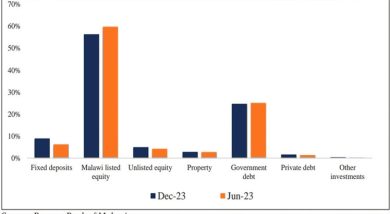Typhoid fever menace
Looking at the dimensions of rural development, linkage between agriculture and health has often been overlooked. Yet the realities on the ground manifest how the two intertwine and impact rural livelihood.
The majority of rural livelihoods are farmers speckled by hunger, low income and incapacitating sicknesses such as salmonellosis (typhoidal and non-typhoidal salmonella) linked to consuming unhygienic food due to poor water, food handling processing and bacteria transmissible from farm animals to humans.
Febrile illness and invasive diseases could have disastrous effects on agriculture and rural livelihood, through the loss of labour due to illness or deaths, loss of knowledge, as well as household assets. So coordinating agriculture and health interventions can yield significant benefits for the poor in Malawi.
Malawi is an agro-dependent country with agriculture impacting health and the economy. Economically, agriculture contributes about 36 percent of GDP and provides jobs to multitudes.
From the health point of view, agriculture provides nutritious food, medicinal herbs or plants and income that are spent on healthcare. Despite all the positive health impacts of agriculture, there also exist health crashes limiting agricultural production resulting from food-borne diseases or poor management of farm animals.
Taking an integrated view of agriculture and health is necessary to prevent illnesses and promote agriculture for development.
The lack of coordination of policy making between agriculture and health undermines efforts to overcome ill health among the poor and gives short shrift to agriculture’s role in alleviating many of the Malawi’s most serious health problems.
Typhoid fever refers to severe and occasionally life-threatening febrile illness caused by salmonella bacteria called typhi or paratyphi A/B/C. Non-Typhoid (NTS) refers to illness caused by all types of salmonella except for typhi and paratyphi A/B/C. Humans and animals are sources of bacteria transmission through consuming contaminated water or food.
On average, there are 22 million cases with 200 000 deaths from typhoid fever globally each year, 94 million cases with 115 000 deaths from NTS globally each year. Substantial increase in typhoid fever from 14 per year in 1998-2010 to 843 per year in 2013 was confirmed at Queen Elizabeth Central Hospital. Both typhoid fever and NTS are characterised as diseases of developing countries as evidence points to deteriorating sanitation conditions in these countries. Salmonella bug is sensitive to different agricultural season patterns hence multiyear epidemics during rainy seasons are a common thing. Typical symptoms and signs of NTS or Typhoid fever would be fever, headache, malaise, abdominal pain, diarrhoea, constipation, and rose rash.
The livestock revolution in developing countries has been associated with the growth of unprecedented concentrations of animals in the urban, peri-urban and rural areas of developing countries, with major implications for human health.
Of 1 415 infectious organisms known to cause disease to humans, 61 percent are caused by animals, or transmissible from animals to humans. The poor are especially exposed because of the proximity of their living spaces to farm animals. Storage of agricultural products in unhygienic location may lead to contamination.
The primary method of prevention is to keep farm animals far away from living space. If space is not sufficient or there are security concerns, it is important to prioritise sanitation coupled with boiling animal meat, water or milk long hours before consuming.
Stagnant water and slow-moving rivers should be avoided as source of washing or bathing water. This will help prevent getting exposed to the Salmonella. Both typhoid and NTS can be treated with anti-biotics although the issue of multi-drug resistance is on rise.
Typhoid fever can be controlled through vaccination but unfortunately it is not rolled out in Malawi due to lack of additional information about when, where and who to vaccinate besides costs implications. No NTS vaccine exists.




